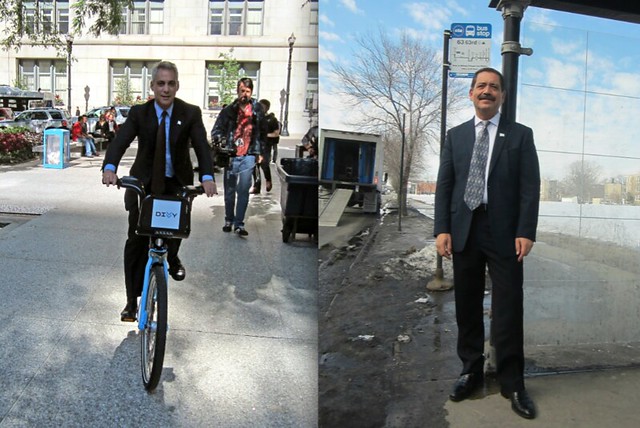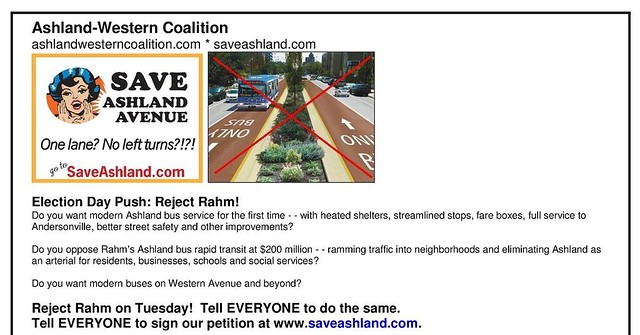Whether you were rooting for Mayor Rahm Emanuel or Cook County Commissioner Jesús “Chuy” García, I think most Streetsblog readers will agree that there were some positive outcomes for sustainable transportation in yesterday’s municipal runoff election. Regardless of how you feel about Emanuel in terms of the economy, education, crime, transparency, ethics, and other issues, it’s safe to say he was the more progressive candidate when it comes to walking, biking, transit, and traffic safety.
For all his faults, the mayor has racked up an impressive list of transportation achievements during his first term, which got little airtime in the election coverage. These include the successful south Red Line reconstruction, many new and rehabbed ‘L’ stations, and the start of the Loop Link bus rapid transit project. We’ve seen an increased focus on reducing pedestrian fatalities, including plenty of new safety infrastructure. Big projects for bicycling have included dozens of miles of buffered and protected lanes, Divvy bike-share, and the Bloomingdale Trail.
García’s transportation platform, which voiced support for the Transit Future campaign for a dedicated funding at the county level, as well as for winning a fair share of state transportation dollars for the Chicago region, suggested that he understands the need for a high-quality transit system. When I interviewed him for Newcity magazine, the commissioner also said he was interested in creating a line item in the city budget for pedestrian infrastructure, and he praised Emanuel’s bike initiatives.
However, there were indications that the rate of transportation progress would have slowed down under a García administration. He told me he’s in favor of road diets and protected bike lanes, both of which became common over the last four years. However, he said that a more extensive community input is needed for road diets, and he would only install PBLs “where there’s good support for building [them.]”
Worse, the commissioner’s positions on automated traffic enforcement and the city’s plan for BRT on Ashland Avenue were downright reactionary, and seemed calculated to attract votes from disgruntled drivers. García and the other mayoral challengers deserve credit for drawing attention to ways that the Emanuel administration mismanaged the traffic cam program, including questionable locations, malfunctioning cameras and more. As a result, the mayor recently pledged to remove red light cams from low-crash intersections and make other changes to help rebuild Chicagoan’s confidence in the program.
However, García threw out the baby with the bathwater by promising abolish, rather than reform, automated enforcement if elected, even though numerous studies have shown that well placed cams have been very successful in reducing serious crashes and fatalities in other cities. Although he argued that the program unfairly targeted low-income and working-class Chicagoans, there's actually a higher density of cams in the city's more affluent neighborhoods. Moreover, Chicago’s worst intersections for pedestrian crashes involving children are located in low-income neighborhoods and, from my experience scanning news stories for Today’s Headlines, it appears that the majority of serious traffic crashes take place on the South and West Sides.
Likewise, García’s opposition to the Ashland BRT plan, which would nearly double bus speeds via dedicated lanes and other time-saving features, appeared to be a case of pandering to motorists. “This project cannot be approved in its current form, and frankly may never be appropriate for approval,” he told the Sun-Times.
The commissioner was arguably a strong candidate in many respects, but when it comes to transportation, he must be judged by the company he keeps. He was endorsed by the anti-BRT group the Ashland-Western Coalition, which sent out an unintentionally hilarious “Reject Rahm!” mailing. García also signed the Citizens to Abolish Red Light Cameras' pledge to get rid of the cams, and won their endorsement. The group also backed five anti-cam aldermanic candidates -- I’m happy to report that most of these candidates lost their races as well.
There was some other good news for walking, transit, and biking in the aldermanic runoff results. 2nd Ward victor Brian Hopkins, an aide to a Cook County Commissioner John Daley, has demonstrated a solid understanding of bike safety issues in presentations on trails projects before the Mayor’s Bicycle Advisory Council.
45th Ward incumbent John Arena, who has come under fire from residents for his support for the Milwaukee Avenue road diet and the Jefferson Park Pedestrian Street designation, beat his opponent John Garrido, a police officer who led the charge against the road diet. And 46th Ward Alderman James Cappleman, a strong supporter of transit and bike projects in Uptown, survived a challenge from attorney Amy Crawford.
As far as I know, none of the other races involved candidates who have made headlines for their positions on sustainable transportation issues. However, if you live in one of the other wards that held a runoff, give us your take on how the outcome will impact walking, transit, biking, and traffic safety in the comments section.





